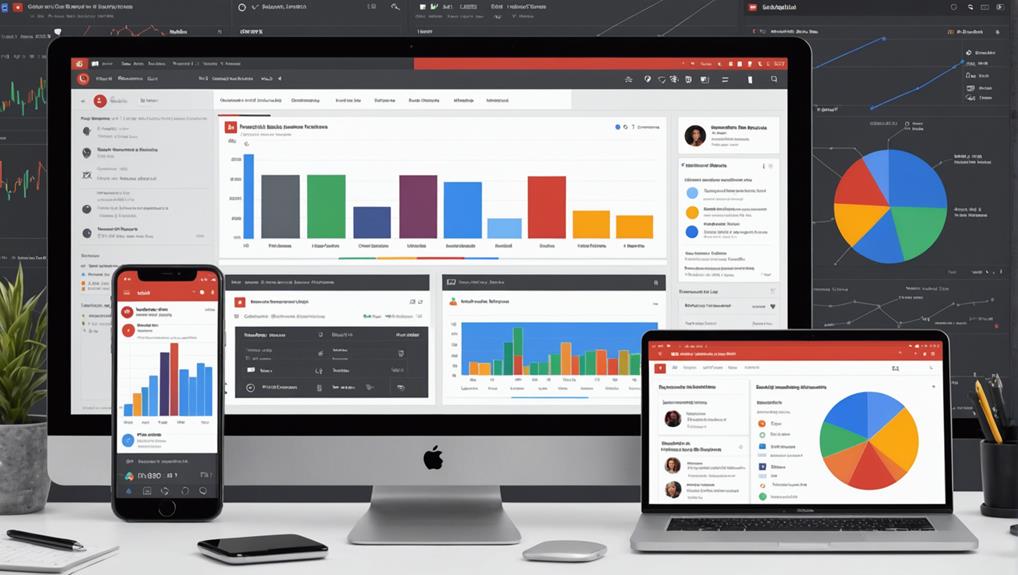YouTube influencer marketing entails key costs including influencer partnership expenses, pricing models, and hidden operational fees. Partnership expenses can range from $20 to over $20,000 depending on influencer size, with an average minimum of $2,500 for sponsored content. Pricing models are heavily influenced by subscriber count and engagement rates, leading to varied content costs. Hidden costs such as content creation, legal fees, and agency charges can considerably inflate budgets, with unforeseen content expenses alone ranging from $500 to $10,000. Examining these elements offers a more thorough understanding of financial outlays and strategic planning opportunities. Discover more insights within these aspects.
Key Takeaways
- Influencer fees vary by subscriber count, with nano-influencers charging $20-$200 and mega-influencers demanding $20,000 or more per post.
- Hidden costs include unforeseen content creation expenses, ranging from $500 to $10,000, impacting overall campaign budgets.
- Legal fees for contracts and usage rights can increase budgets by 10-20%, adding complexity to partnership expenses.
- Influencer agency fees can constitute 15-30% of total campaign budgets, influencing the overall cost-efficiency.
- Performance tracking and analytics tools may cost $100 to $1,000 monthly, essential for evaluating campaign success.
Influencer Partnership Expenses
The financial landscape of YouTube influencer marketing is diverse, reflecting a wide range of partnership expenses that businesses must consider. YouTube influencer marketing costs vary greatly, influenced by factors such as subscriber count, content type, and engagement rates. Nano-influencers charge between $20-$200 per video, whereas mega-influencers can demand $20,000 or more for a single post. This disparity highlights the critical role of influencer partnership expenses in strategic budgeting.
The average minimum price for sponsored content on YouTube is approximately $2,500. This figure underscores the platform’s requirement for higher production value and its potential for substantial engagement. A key consideration is the production costs associated with content creation, which are generally higher on YouTube due to the necessity for quality filming and editing. These factors contribute to the overall expenses businesses face when leveraging YouTube influencer partnerships.
Micro-influencers often offer a better ROI due to their niche audiences and higher engagement rates. However, contracts for YouTube collaborations can further increase expenses through deliverables, usage rights, and exclusivity clauses.
Consequently, understanding the intricate dynamics of YouTube influencer partnership expenses is essential for optimizing marketing investments and achieving desired outcomes.
Pricing Models Analysis
Analyzing pricing models in YouTube influencer marketing reveals a complex interplay of factors contributing to compensation structures. Influencer compensation is heavily influenced by subscriber count, with Nano influencers (under 10,000 subscribers) charging between $20 and $200 per video. In contrast, Mega influencers (over 1 million subscribers) command fees of $20,000 or more. This disparity underscores the significance of the influencer’s reach and the perceived value they deliver to brands.
Key elements affecting these pricing models include:
- Engagement Metrics: Beyond subscriber count, audience interaction rates notably influence costs, as they indicate the active involvement of viewers with the content.
- Content Cross-Promotion: Brands leverage influencers to promote content across multiple platforms, which can lead to varied pricing depending on the complexity and reach.
- Content Format: While traditional long-form content remains essential, the rise of YouTube Shorts introduces a dynamic pricing model, offering new opportunities and challenges.
These factors highlight the evolving landscape of YouTube influencer marketing. As average pricing is projected to rise from $3,000 in 2019 to $8,000 per video by 2024, brands must strategically assess these variables to optimize their investment in influencer partnerships.
Hidden Costs Breakdown
Exploring the landscape of YouTube influencer marketing reveals a host of hidden costs that can considerably impact a brand’s budget. While influencer marketing costs may seem straightforward, brands often face unforeseen content creation expenses. These can range from $500 to $10,000, dictated by the video’s complexity and production quality.
Legal fees, important for securing contracts and usage rights, can unexpectedly inflate the campaign budget by 10-20%. This is compounded when additional deliverables, like multiple edits or extended usage rights, are required, leading to further budgetary strains.
Engaging influencers through third-party firms introduces influencer agency fees, accounting for 15-30% of the total campaign budget. This often overlooked component of influencer marketing costs can substantially increase overall expenses.
Additionally, effective performance tracking is necessary; however, the costs associated with analytics tools must not be underestimated. Some platforms charge monthly subscriptions ranging from $100 to $1,000, depending on the suite of services provided.
Ultimately, understanding these hidden costs is essential for brands aiming to optimize their campaign budgets. An in-depth analysis of influencer marketing costs is critical to guarantee a thorough strategy that anticipates and manages these potential financial surprises.
Frequently Asked Questions
How Much Does Influencer Marketing Cost UK?
Influencer pricing in the UK varies based on audience engagement and niche selection. Effective campaign strategies and brand partnerships often depend on performance metrics, content creation quality, platform trends, measurement tools, and cultivating long-term relationships with influencers.
What Is the Conversion Rate for Youtube Influencer Marketing?
The conversion rate for YouTube influencer marketing typically ranges from 1% to 3%, influenced by YouTube metrics, audience engagement, and content authenticity. Effective influencer selection, brand alignment, niche targeting, and collaboration strategies enhance performance tracking and campaign duration.
What Is the Average Budget for Influencer Marketing?
The average campaign budget allocation for influencer marketing varies considerably across influencer tiers, niche considerations, and platform selection. Brands should emphasize audience engagement, content creation, long-term strategy, performance metrics, and brand alignment to optimize their investment.
Is 89% of Marketers Believe That ROI From Influencer Marketing Is Comparable to or Better Than Other Marketing Channels?
An overwhelming 89% of marketers affirm that influencer marketing’s ROI comparison demonstrates superiority over other channels, attributed to influencer credibility, audience engagement, content authenticity, niche targeting, and analytics tracking, fostering consumer trust through strategic brand partnerships and campaign longevity.
Conclusion
The analysis of YouTube influencer marketing costs reveals significant financial considerations. Influencer partnership expenses, encompassing fees for collaboration and content creation, constitute a primary expenditure. A detailed examination of pricing models highlights the variability in costs based on influencer reach and engagement metrics. Additionally, hidden costs, such as platform fees and campaign management expenses, add complexity to budget allocations. Understanding these components is essential for optimizing marketing strategies and achieving desired outcomes in influencer-driven campaigns.




